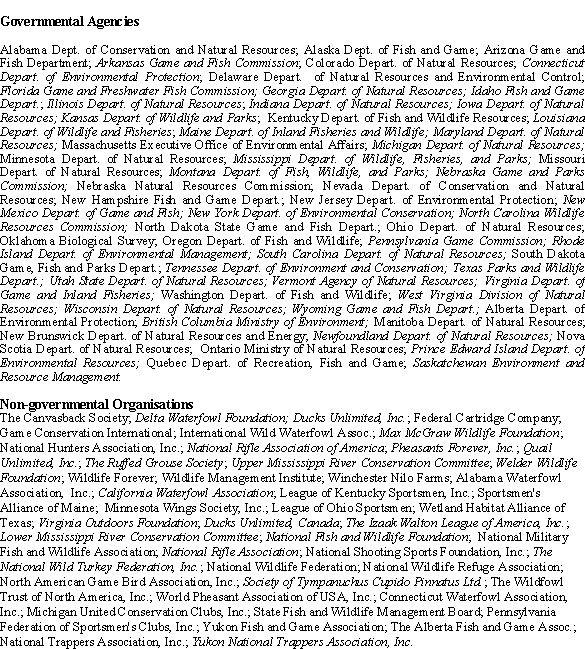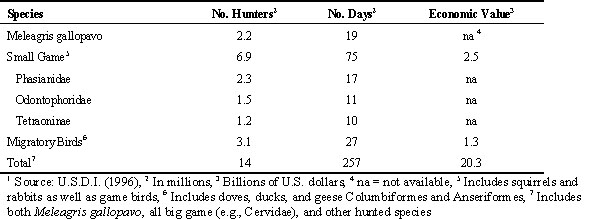
S35.3: Game birds as keys to conservation of North American avifauna
R. J. Gutiérrez1 & Leonard A. Brennan2
1Department of Wildlife, Humboldt State University, Arcata, California, USA, fax 707 826 4060
, e-mail rjg4@axe.humboldt.edu; 2Tall Timbers Research Station, Tallahassee, Florida, USA Gutiérrez, R.J., & Brennan, L.A. 1999. Game birds as keys to the conservation of North American avifauna. In: Adams, N.J. & Slotow, R.H. (eds) Proc. 22 Int. Ornithol. Congr., Durban: 2104-2124. Johannesburg: BirdLife South Africa.Hunting and hunters are major economic, political, and conservation forces in North America. Hunting contributed more than $20 billion to the United States economy in 1996. Game bird hunting contributed over $3 billion in 1996. Special game bird stamps must be purchased by hunters in many states and from the Federal government to hunt waterfowl. These stamps have generated over $623 million which has been used to purchase or protect over 2.2 million ha of critical wildlife habitat. More than 76% of all North American bird species use habitat on 71 National Wildlife refuges that were purchased with Migratory Bird Hunting Stamp funds for breeding, wintering, or year-round residency. Non governmental organisations are also active in conservation of game birds. Membership in these groups is well over 1 million people. These groups have collectively raised over $1.2 billion for research, habitat improvement and restoration, and outright purchase or leasing of critical habitat. Collectively, they have protected over 10.5 million ha of habitat. We submit that hunting and hunters are critical components of avian conservation in North America. Their contributions rarely are recognised at national or international scales but are essential if we are to maintain a diverse native avifauna on a continental scale.
INTRODUCTION
The roots of the conservation movement in the United States are linked directly to the conservation of game species (Reiger 1978; Trefethen 1975). Commercial exploitation of game species, and subsequent declines in many of these species, raised concern among hunters with an interest in a fair chase philosophy of hunting. Many of the most influential people in North America at the turn of the last century were both fair chase (i.e. non-commercial) hunters and avid conservationists. Teddy Roosevelt, 26th President of the United States, was a classic example of an influential person who assumed this type of conservation leadership. These political and business leaders galvanised the support of the average American hunter to: (1) support restriction of market (commercial) hunting; (2) regulate legal game harvest; and (3) establish seasons with various additional restrictions that were relevant to the biology of particular game species (e.g. not hunting waterfowl during northward migration). In conjunction with the emergence of restrictions on taking of game species, many wildlife refuges were established at both state and national levels. The primary goals of these refuges were to protect both the individual species and their habitat.
We define 'conservation' herein as 'wise use' of a natural resource following North American wildlife management principles (Leopold 1933). [It is important to note that this definition not be confused with a powerful anti-conservation group in the United States which euphemistically refers to itself as the 'Wise Use Movement.'] This definition is in contrast to the European definition of 'conservation' which generally means 'preservation' (Frankel and Soulé 1981).
Despite numerous enacted game laws and restrictions on market hunting, game populations continued to decline during the first part of the 20th century. These continued declines led to an international migratory bird species treaty with Canada which was designed primarily to protect waterfowl, but broadly written to include all migratory species. This act was widely supported by hunters, but abhorred by some states because of Federal government usurping the 'State's Right' to manage the wildlife within its borders (Bean 1977). Concomitant with the rise in Federal interest in game conservation, many states began efforts to restore depleted game populations (e.g. Leopold 1931). These investigations resulted in the establishment of modern wildlife management in North America (Leopold 1933). Leopold (1933) recognised early that game laws were only a single facet to restoration of game populations. More importantly, he recognised that habitat was the key to long-term sustainability of all game and wildlife populations.
Game management strongly influenced the initial development of wildlife management and conservation in North America. Following the Vietnam War, the emphasis gradually changed to a more holistic approach to wildlife management (Peek 1986). This transition was stimulated further by the paradigm of Conservation Biology (Soulé and Wilcox 1980). In addition, during the past three decades, a vocal and active movement dedicated to animal rights and welfare emerged (Decker and Brown 1987; Richards and Krannich 1991). While the attention of these latter groups focused on commercial exploitation of wildlife or use of animals in research, many were decidedly opposed to fair chase hunting, game management, and killing of individual animals for reasons deemed unnecessary by their personal standards. Many also opposed conservation efforts (e.g. disrupting efforts to control alien species that were designed to protect unique biodiversity on islands). As a result of such animal rights initiatives, modern wildlife management programs have wasted considerable, scarce resources dealing with challenges to regulated fair chase hunting.
The high media profile given to antagonistic actions by special interest groups has over shadowed more important, concrete conservation action by hunters in North America, particularly the United States. It is against this background of high profile anti-hunting sentiment by vocal special interest groups that we present the tremendous contributions made by hunters to the conservation of North American avifauna and their habitat under the auspices of game bird conservation. We do this by examining the general contributions made by game bird hunters to the general economy and land preservation. We also present examples of two game birds of different profile and interest to hunters, the Northern Bobwhite Colinus virginianus and the Mountain Quail Oreortyx pictus, whose welfare have led to major changes in land management practices and habitat preservation.
METHODS
Economic Assessment of Game Bird Hunting
The source of statistics for the economic impact of game bird hunting in the United States is the U. S. Bureau of the Census (U.S.D.I 1996). Every four years, the economic impact of hunting, fishing, and wildlife recreation (i.e. non exploitation) activities is assessed by a national survey. The data reported here are an underestimate of the economic impact because Wild Turkeys, Meleagris gallopavo, are classified as big game in the survey. Hence, the economic statistics of Wild Turkey hunting cannot be separated from big game statistics.
Dedicated Funding for Research, Education, and Land Acquisition
Funding specifically raised by hunters to purchase or improve habitat, support research, or increase knowledge of game birds comes from many sources in North America. Among these are: special stamps purchased from state and Federal governments--the proceeds of which go to habitat acquisition, research, etc.; direct donations (i.e. philanthropic giving); and membership dues in organisations dedicated to conservation of specific species of game birds. We sent a questionnaire to every state government and non governmental organisation (NGO) concerned with conservation of game birds requesting information on dedicated funding derived from hunters or from members of the NGO (Appendix 1). The purpose of this survey was to obtain information on how funds generated either directly or indirectly from hunting activities influenced both game and non game birds, as a function of habitat preservation, land acquisition, or some other factor.
Impact of Migratory Bird Hunting Stamp Purchases on North American Avifauna
All hunters in the United States are required to purchase a Migratory Bird Hunting Stamp before hunting waterfowl. The funds derived from these sales are used to purchase or lease habitat for waterfowl. As one measure of the general impact of these acquisitions on the North American avifauna, we downloaded, via the Internet, bird species occurrence lists from each National Wildlife Refuge in the United States. We determined which refuge was purchased primarily using Migratory Bird Hunting Stamp funds by questionnaire to the U.S. Fish and Wildlife Service. Unfortunately, only refuges purchased since 1962 were included in the assessment because available records of documentation are computerised only since 1962. Hence, the following evaluation is an assessment of minimum impact. We then filtered the bird list by refuges purchased by hunting stamp funds to estimate the number of resident, breeding, or wintering species on these refuges. No inference is possible regarding the viability of bird species populations on these refuges, rather it is a simple presence or absence index.
Case Studies of Individual Species
We used two upland game bird species (Northern Bobwhite and Mountain Quail) as examples of how hunters interested in a particular game bird can dramatically affect the welfare of other avian species. We chose these two galliforms because we have conducted a great deal of research and conservation work on them and because they are very different in their economic and statistical importance as game species. Therefore, the source of our information is personal research and the literature.
Huge sums (millions of dollars per year) are spent on Northern Bobwhite habitat management, whereas Mountain Quail habitat management is mostly a function of prevailing land uses, even though this bird is prized by many upland game bird hunters. Because of these different management scenarios, Northern Bobwhite and Mountain Quail represent the ends of a continuum that ranges from intensive to passive approaches to habitat management.
RESULTS
Economic Assessment of Game Bird Hunting
Fair chase hunting has been a major economic activity in the United States. Approximately 20.3 billion U.S. dollars (all figures reported in this paper are in U.S. dollars) were spent on hunting in 1996 (Table 1, Fig. 1A). Note that this number is much higher than that provided in Fig. 1A because $7.1 billion in hunting expenditures were unspecified in the U.S. census bureau survey or were for species other than those listed in Fig. 1A. Waterfowl and small game hunting (which includes small mammals as well as game birds) accounted for approximately $3.8 billion of expenditure (about 30% of the total for all hunting activity (Fig. 1B)). During 1996, there were approximately 10.3 million hunters who spent about 84 million days pursuing their quarry.
Economic activity follows the trends in numbers of active hunters (Fig. 1 and Fig. 2; r = 0.697, P = 0.054, F1,6 = 5.67) for the period 1955 - 1990. This correlation is not significant if 1996 data are included (r = 0.381, P = 0.312). This could be related to the general economic strength of the USA economy during the last survey period (U.S.D.I. 1996) resulting in higher than normal expenditures following an inflationary period. The number of active hunters increased from 1955 to 1975 and then declined slightly from 1975 to 1991, but the overall trend is not significantly different from a slope of zero ( r = 0.386, P = 0.305). In contrast, the number of big game hunters increased significantly over time ( r = 0.889, P = 0.0013, F1,7 = 26.35). Waterfowl hunters also increased over time but it was not significant (r = 0.604, P = 0.085). The overall trend was nearly stable for small game hunters (r = 0.473, P = 0.199) but clearly showed an increase during the first 20 years and then sharp decline during the second 20 years. During the period of decline of small game hunters there was a substantiated decline in numbers of most quail species (Brennan 1993). Habitat loss has accelerated in rural areas near cites as urbanisation increases. These losses would occur in areas typically used for the pursuit of small game. Of interest is the fact that general wildlife watching and feeding (as a measure of non consumptive use of wildlife) declined sharply between 1991-1996.
Dedicated Funding
Dedicated funding for game bird conservation comes from three sources in North America: state (or provincial) wildlife agency, Federal government, and private sources. In every state and province all bird hunters (with the exception of some indigenous peoples) must purchase a hunting license. These funds can account for either a very small or a relatively large proportion of state agency budgets (Table 2). The budgets of provincial resource agencies are not significantly influenced by game bird hunting. However, license receipts do not necessarily benefit game bird conservation directly. Although a state may derive a large proportion of its budget from game bird hunting licenses, it may allocate those funds to a variety of activities that do not directly benefit game birds (Brennan 1993). In contrast, the sale of state, provincial, or Federal waterfowl and game bird hunting stamps directly benefits those species through research, education, or habitat acquisition. A stamp is a form of license or tax required before hunting of the species can legally occur, it differs from general hunting licenses in that it is a dedicated source of funding usually created by legislation.
Impact of Migratory Bird Hunting Stamp Purchases on North American Avifauna
In 1934, at the request of hunters and wildlife professionals, the United States government issued the first game bird hunting stamp. This stamp is generally referred to as the Migratory Bird Hunting Stamp. It required special legislation (The Migratory Bird Hunting Stamp Act) at the Federal level of government. The cost of the original stamp was $1. The cost of the stamp rose gradually from $1 - $5 from 1934 - 1978. From 1979 - 1997 it rose more sharply from $5 - $15. Consequently, the revenue generated from the sale of these stamps has also increased over time (Fig. 3A). The purposes of the stamps are to: (1) raise money to purchase wetland/waterfowl habitat; (2) buy wetland conservation easements; and (3) provide management funds for waterfowl. Purchase of these stamps has resulted in $520583446 raised for waterfowl and wetland habitat conservation over its 63-year history.
These funds have been used in concert with funds derived from a Federal excise tax of 10% levied on the sale of all sporting arms and ammunition. These tax funds were designed to produce a source of revenue to support wildlife research, provide hunter safety education, and to purchase or protect wildlife habitat. The excise tax also was lobbied for by hunters and wildlife professionals. Special Federal legislation (Pittman-Roberston Act) was needed to allow this special tax.
We were unable to evaluate the trend of habitat acquisition prior to 1962, thus, we underestimated (probably substantially) the amount of habitat acquired as well as the number of National Wildlife Refuges purchased with these two hunter-mediated funding sources. However, there was a sharp increase in purchases from 1962-1966 (Fig. 3B). A declining trend in habitat acquisition continued until 1983 (Fig. 3B). From 1984 to the present the trend has been gradually upward. We do not know the causative factor for the sharp decline in habitat acquisition, but likely it was due to a general increase in land values. The trend in lower habitat purchases did not reverse itself substantially until the price of a stamp increased to $12.50 in 1989.
Funds generated from the sale of these stamps are also used to purchase conservation easements. A conservation easement is usually a direct payment to a landowner to either protect habitat or defer certain activities (such as development) that would negatively impact the habitat. Other factors influence land purchases by the Federal government in the United States including political interference and government bureaucracy.
Since 1962 (the date of computerised records), $836 million has been used from the combined sources of the Federal excise tax and the sale of migratory bird hunting stamps to purchase 71 National Wildlife Refuges totalling 373297 ha of critical wetland habitat. In addition, other easements and fee purchases (including waterfowl production areas [i.e. areas of high wetland value where there is a high density of nesting waterfowl]) resulted in 920756 ha of protected habitat.
Although these National Wildlife Refuges were purchased primarily to benefit waterfowl, they have had great peripheral impact on other species. A total of 600 bird species occur on these 71 National Wildlife Refuges. This represents 76.2% (600 of 787 species) of all bird species that have been observed >10 times in North America. In addition, 19 threatened or endangered bird species are also found on the refuges. This represents 25% (19 of 75 species currently listed as endangered under the USA Endangered Species Act) of all threatened or endangered birds in the United States. Again, these are conservative estimates because we were unable to acquire lists from refuges purchased prior to 1962.
Following the great success of the Federal Migratory Bird Hunting Stamp program many states and at least one Canadian province issued either waterfowl and/or game bird hunting stamps. State and provincial funding derived from the sale of these stamps varies greatly (Table 2). Only 63% and 31% of states responding to surveys required hunters to purchase waterfowl or game bird hunting stamps, respectively. Only 20% of responding Canadian provinces required either form of stamp.
A great deal of money has been raised to benefit game birds as a result of the sale of these stamps (Table 2). More importantly, the money generated by those states and province has been used to purchase or protect a minimum 919762 ha of habitat. These areas provide habitat for a wide variety of other bird and animal species. Thus, as a result of a specific activity for game birds many other bird species are positively impacted. Given the immense benefit of these dedicated funds it is surprising that they are not required by all states and provinces.
There are many NGOs devoted to conservation of game birds or their habitats in North America (Table 3; Appendix 1). Well over $1.2 billion has been raised from membership fees, donations, or fund raising events by these organisations for research and habitat conservation. These funds have been used to purchase or protect over 10524484 ha.
One organisation has been particularly effective in sequestering private money for conservation of game birds and their habitat. Ducks Unlimited (DU) has raised over $1 billion and protected over 10.4 million ha of critical habitat since its founding. DU was founded primarily to support the interests of waterfowl hunters (Table 3). In Canada, DU is the most significant conservation force in the prairie biome. Because of low provincial and Federal Canadian budgets most conservation of wetlands in Canada is conducted under the auspices of DU Canada. In fact, DU Canada has been more effective raising money on a per capita basis than DU United States ($0.78 raised/Canadian citizen vs. $0.33 raised/USA citizen). In addition, land is less expensive in Canada than in the USA making private money more effective for habitat conservation. Thus, the Canadian success should serve as an example of the effectiveness of hunter philanthropy for habitat conservation. We point out that the enormous contributions of DU to conservation of wetland habitats have attracted many non hunters to their general cause. Currently, 65% of DU members are waterfowl hunters. Each NGO has different goals and objectives but they all achieve a common purpose in that they positively influence the conservation of the species and its habitat.
Other groups not illustrated in Table 2 strongly support game bird conservation efforts through political action or raising of private funds for conservation. One organisation, National Fish and Wildlife Foundation, is a quasi NGO in that it facilitates cost-share partnerships between the Federal government agencies and other organisations. They also seek private donations. Since their inception in 1984, they have generated $36 million for research and $172 million for conservation activities. In addition, they have been involved in the preservation of 187795 ha of wildlife habitat. Still other groups are more narrowly focused on a particular area or interest yet can still contribute substantial funds for research and conservation as well as protecting habitats. For example, it is a little known fact that the National Rifle Association, well known for its political activism, has raised over $1 million for wildlife research. Some of these groups are listed in Appendix 1.
Perhaps more significantly, the collective political power of organised groups who also make positive contributions to society, like the above-mentioned NGOs, influence conservation decisions by politicians and public conservation agencies. There are very large memberships (Table 3) associated with these organisations which influence political and agency policies regarding conservation. Thousands of decisions are made each year that affect the fate of either species conservation or wildlife habitat. Thus, the political influence of these groups cannot be underestimated regarding the general good it does for either wildlife or avian conservation.
Case Studies of Individual Species
Influence of Northern Bobwhite Management on Other Birds and Their Habitat.
The Northern Bobwhite is a popular upland game bird in the southern and midwestern United States. The Northern Bobwhite occurs over 66% of the land mass of the continental USA, and is pursued by more than 1 million upland game bird hunters each year (Brennan in press). Stoddard (1931) conducted a landmark study of this species and determined that the most abundant populations of Northern Bobwhite in the southeastern USA were directly linked with the frequent use of prescribed fire on the landscape. Stoddard (1931) concluded that this bird ' . . . was undoubtedly evolved in an environment that was always subject to occasional burning....' He generalised these conclusions to other plants and animals by stating, ' . . . fire may well be the single most important factor in determining what animal and vegetable life will thrive in many areas.' Furthermore, and perhaps most importantly, he noted, ' . . . when fire is eliminated, the animal life, adjusted through the ages to the open pine forests, is evicted, along with the associated flora.'
Stoddard’s work on the relationship between Northern Bobwhite and frequent applications of prescribed fire established a scientific basis for the management of this important and popular game species. Recently, there has been emerging interest in how management for Northern Bobwhite influences other species such as the Red-cockaded Woodpecker (RCW; Picoides borealis) (Brennan et al. 1996), and in how RCW management influences other species of birds, including the Northern Bobwhite (Brennan et al. 1995). From a management standpoint, it does not matter if the initial motivation for management (i.e. primarily the application of prescribed fire) is for Northern Bobwhite or RCW (Block et al. 1995). What matters is that frequent applications of prescribed fire are required to develop and maintain stands of mature, open park-like upland pine forest (Brennan et al. 1998) that provides habitat for these, and many other birds. Without frequent use of fire (for Northern Bobwhite, RCW, or some other purpose), upland pine stands quickly become invaded by brush and become unsuitable for many species, including Northern Bobwhite.
Northern Bobwhite and the Longleaf Pine Ecosystem.
The longleaf pine Pinus palustris forest once covered nearly 90 million ha of the southeastern coastal plain in the United States. Today, less than 1.5 million ha of this forest remain (Simberloff 1993) of which less than 6,000 ha are original, primary forest. The longleaf decline was a function of numerous factors related to logging and associated land use practices such as extraction of turpentine for Naval Stores industry (Frost 1993) and fire exclusion. Longleaf pine forests once provided a huge area of pine forest habitat for Northern Bobwhite, but today, this habitat has been highly divided, and reduced by fragmentation. Remnant stands of longleaf, when managed with prescribed fire and other disturbance regimes, can continue to provide high quality habitat for Northern Bobwhite, and numerous other birds. The importance of frequent applications of prescribed fire for good stewardship of longleaf pine (and other species of southern pines as well) cannot be over emphasised.
Effects of Fire Exclusion.
There are at least 10 species of land birds (including Northern Bobwhite and RCW) in the southeastern USA that have declined significantly as the result of fire exclusion (Table 4). When fire is excluded, many species can be rapidly excluded from a forest. For example, experimental research at Tall Timbers Research Station, near Tallahassee Florida, showed that 14 species of birds were completely eliminated from an upland pine forest within 15 years (average = 9 years of fire exclusion) after use of prescribed fire ceased (Engstrom et al. 1984). Some species, such as Loggerhead Shrike Lanius ludovicianus, Eastern Kingbird Tyrannus tyrannus, and Blue-gray Gnatcatcher Polioptila caerulea disappeared after as little as 2-4 years of fire exclusion (Table 5).
Effects of Frequent Fire for Northern Bobwhite and/or RCW Management on other avifauna.
In Mississippi, Brennan et al. (1995) observed that at least 9 species of land birds were positively influenced by frequent applications of fire for RCW habitat management (Table 6). Management personnel at the areas used by Brennan et al. (1995) acknowledged that much of their RCW habitat management was based on Stoddard’s ideas about Northern Bobwhite habitat management. Additional work by Wilson et al. (1995) in Arkansas supported observations from Mississippi by showing that at least 20 species of land birds were positively influenced by frequent applications of fire (Table 7). In the Apalachicola National Forest in northern Florida there were at least 21 species of land birds with an affinity for frequently burned habitat; in the Sandhills of North Carolina, there were 28 species (Engstrom et al. 1994).
Need for Increased Use of Fire.
There is a critical need for more prescribed fire on a landscape scale, both in the southern USA and elsewhere (Brennan et al. 1998). The southern USA is rapidly developing into a vast matrix of unburned forest habitats with only occasional patches of public land managed with frequent fire (Brennan et al. 1998). Applications of prescribed fire in six southern states range from about 2.5% of the land area (Florida) to less than 0.01% (Mississippi) (Brennan et al. 1998). Private lands (about 200000 hectares) managed for Northern Bobwhite hunting in northern Florida and southern Georgia are a notable exception to the region-wide trend toward fire exclusion on private lands (Brennan et al. 1996). In fact, the land management example set by these private owners as a direct result of their long-standing interest in hunting the Northern Bobwhite is becoming a model throughout the United States for the application of prescribed fire to maintain the native biodiversity of the area.
Lack of fire, and changing land uses in agriculture and forestry have resulted in a 70-90% decline in Northern Bobwhite populations during the past three decades (Brennan 1991). With the broad-scale elimination of fire (and hence reduction of management for Northern Bobwhite, whether intentional or not) we are currently witnessing an unintentional, landscape-scale experiment of epic proportions. Along with Northern Bobwhite, an entire suite of grassland and open forest birds are threatened by habitat loss. However, expanded interest in habitat management for both Northern Bobwhite (Brennan 1993) and RCW (Kulhavy et al. 1995) could potentially benefit at least 20-30 species of land birds in the southeastern USA, if prescribed fire is used for habitat management on appropriate scales of space and time.
The influence of Mountain Quail declines on the conservation of threatened Great Basin habitats.
Compared to the Northern Bobwhite, the Mountain Quail is not a widely hunted game bird because relatively low density populations are widely dispersed in steep, remote, or inaccessible habitats (Gutiérrez and Delehanty in press). It is hunted in only three western states and one Canadian province. Nevertheless, the Mountain Quail is a highly prized quarry for avid bird hunters in the western USA.
Compared to the Northern Bobwhite, neither a strong hunting tradition nor a large cadre of hunters devoted to its pursuit has developed. Despite these obvious limitations to conservation action, a group of hunters formed a temporary organisation, The Chukar Foundation, to foster conservation of declining populations of Mountain Quail and other game birds associated with Great Basin habitats. The Great Basin is a large 518,000 km2 semiarid steppe punctuated by isolated mountain ranges in the western USA.
Mountain Quail are endemic to the mountains of the far western United States and Baja California Norte, Mexico. In most of their range populations are stable or possibly increasing (Gutiérrez and Delehanty in press). However, in the Great Basin they are declining rapidly (Brennan 1990). Their decline is precipitated by loss of habitat through overgrazing, hydroelectric development, and changes in microclimate associated with human-made lakes (Brennan 1990). This decline is particularly apparent in Idaho.
Mountain Quail hunting has not been allowed for many years in Idaho. Yet a group of dedicated hunters formed a group specifically to lobby public conservation agencies to protect the habitat of the Mountain Quail from further deterioration. Although the group did not persist for more than a few years, it was sufficient to galvanise agencies into forming working groups to formalise conservation strategies to protect or enhance this species habitat (Vogel and Reese 1995). Although the initial emphasis was on Mountain Quail and other game birds, other species of birds will benefit from this activity. For example, the riparian habitat favoured by the Mountain Quail is one of the most threatened habitats in the western United States. It is also the richest habitat in terms of avifaunal diversity (Freemark et al. 1995).
DISCUSSION
It is apparent that hunters have made, and continue to make, enormous financial, habitat, and political contributions to the conservation of North America’s fauna. The contributions range from political pressure for establishment of hunting seasons and bag limits, to the direct purchase of land for habitat conservation. While the concept of hunters being avid conservationists may seem paradoxical to many ornithologists, it is clear that they have been an integral component of the evolution of conservation strategies in North America. On the one hand, it is in the self interest of hunters to engage in programs that perpetuate their activities. On the other hand, the level of their activity goes well beyond simple self interest as illustrated by the case of the Mountain Quail in western North America.
Hunting is a major economic activity in North America. Hunting license sales alone account for the majority of funding for state wildlife conservation agencies. The sale of special stamps provides specific dedicated funding for game birds which, in turn, provides habitat for the species of interest and all other wildlife species with similar habitat affinities. Annually, over $20 billion of economic activity is associated with hunting, of which more than $4 billion is associated with game bird hunting. Cumulatively, over $1 billion of private funds have been raised for game bird conservation; over 32 million ha of habitat have been protected directly as a result of the contribution of game bird hunters or those interested in their habitat.
One aspect of this economic activity that is not discussed above is the land leasing aspect of hunting. Many hunters or hunting organisations lease land for their sole use during hunting seasons. This leasing not only provides economic return to the land owner, it also provides a major incentive to maintain land in a more natural habitat condition. This, in turn, provides habitat for both the game species of interest and wildlife in general. In some instances hunting leases provide more income to land owners than traditional agricultural uses. In California, the leasing of land for waterfowl hunting provides an essential element to the conservation of habitat for wintering waterfowl in the Pacific Flyway of North America. Without these leased lands, conversion of these lands to agricultural use is inevitable and would have catastrophic negative impact on the entire Pacific Flyway waterfowl. These leased lands supplement habitat found on national wildlife and state waterfowl refuges found throughout the Central Valley of California. Thus, the majority of wetlands used by waterfowl and other species in the Pacific Flyway of California can be directly linked to the activities of hunters.
In summary, without hunting and hunters, wildlife conservation in America would neither be as strong nor as advanced as it is today. Further, the loss of critical habitats like wetlands, tall and short grass prairies, and riparian forests would be far more advanced and perhaps in irreversible decline. Hunters have provided a counter balance to other economic activities that would have resulted in the destruction of wildlife habitat throughout North America. These other activities still lead to massive losses of habitat, but their impact has been substantially reduced through the efforts of hunters, particularly game bird hunters. In this age of increasing criticism of hunting and hunters by anti-hunter (i.e. animal welfare) organisations, it is important to recognise the immediate and tangible benefits of hunting and hunters as well recognise their past contributions. Animal welfare groups do not contribute substantially to direct conservation of habitat nor to the preservation of species. For most of these groups, their interest is in the preservation of individual animals (Kellert 1980). A sense of ethical treatment of animals is a necessary part of society and hunting. However, we believe it is counterproductive (and wasteful of critical resources) to the overall conservation of wildlife in North America and the world not to recognise and support the positive past, present, and future key roles hunters and hunting play in the conservation of wildlife.
ACKNOWLEDGEMENTS
We thank Jeff Dunk and Brian Twedt for help in compiling data used in this paper. Bob Behrstock and K. T. Gutiérrez provided additional information and reviews. Many employees of state, provincial, and Federal government wildlife agencies as well as non governmental organisations kindly filled out the questionnaires; we gratefully list their agencies and organisations in Appendix1. We would especially like to thank Dr. Alan Wentz, Ducks Unlimited, and Mr. Jeff Donahoe, USA Fish and Wildlife Service, for organising and compiling data for their organisations. Humboldt State University Foundation and the American Ornithologists' Union provided travel grants to RJG. Tall Timbers Research Station provided library facilities and space to RJG during the primary writing of this paper.
REFERENCES
Bean, M.J. 1977. The evolution of national wildlife law. Council on Environmental Quality, Washington, D.C. 485 pp.
Block, W.M., Finch, D.M. & Brennan, L.A.. 1995. Single-species versus multiple-species approaches for management. In: Martin, T. E. & Finch, D. M. (eds) Ecology and management of neotropical migratory birds. London; Oxford University Press: 461-476.
Brennan, L.A. 1990. What happened to the Mountain Quail in Idaho. Quail Unlimited Magazine 9: 42-43;69.
Brennan, L.A. 1991. How can we reverse the Northern Bobwhite population decline? Wildlife Society Bulletin 19: 544-555.
Brennan, L.A. 1993. Strategic plan for quail research and management in the United States: introduction and background. Proceedings of the National Quail Symposium 3: 160-169.
Brennan, L.A. (in press) Northern Bobwhite. The Birds of North America: Life Histories for the 21st Century. American Ornithologists’ Union and Philadelphia Academy of Natural Sciences. Washington, D. C.
Brennan, L.A., Cooper, J.L. Lucas, K.E. Leopold, B.D. & Hurst G.A.. 1995. Assessing the influence of Red-cockaded Woodpecker habitat management on non-target forest vertebrates in loblolly pine forests of Mississippi: study design and preliminary results. Red-cockaded Woodpecker Symposium Proceedings 3: 309-319.
Brennan, L.A., Engstrom, R. T. Hermann, S. M. Moser, W. K. Lee, J. M, Lindeman, S.T. Fuller, R.S. & McGorty K. 1996. Ecosystem management research on private lands: access, co-operation and obligations. In: Williams, R. (ed.) Proceedings of the Conference on Forest Ecosystem Management in the Gulf Coastal Plain. Ruston ; Louisiana Tech University: 109-123
Brennan, L.A., Engstrom, R.T. Palmer, W.E. Hermann, S.M. Hurst, G.A. Burger, L.W. & Hardy C.L. 1998. Whither wildlife without fire? Transactions of the North American Wildlife and Natural Resources Conference 63: 000-000 (In press).
Decker, D.J., & Brown T.L. 1987. How animal rightists view the wildlife management hunting system. Wildlife Society Bulletin 15: 599-602.
Engstrom, R.T., Crawford, R.L. & Baker W.W. 1984. Breeding bird populations in relation to changing forest structure following fire exclusion: a 15-year study. Wilson Bulletin 96: 437-450.
Engstrom, R.T., McNair, D.B. Brennan, L.A. Hardy, C.L. & Burger L.W. 1996. Influence on birds of dormant versus lightning-season prescribed fire in longleaf pine forests: experimental design and preliminary results. Transactions of the North American Wildlife and Natural Resources Conference 61: 200-207.
Frankel, O.H., & Soulé M.E. 1981. Conservation and evolution. Cambridge; Cambridge Univ. Press. 327 pp.
Freemark, K.E., Dunning, J.B. Hejl, S.J. & Probst J.R. 1995. A landscape ecology perspective for research, conservation, and management. In: Martin, T. E. & Finch, D. M. (eds.) Ecology and management of neotropical migratory birds. London; Oxford University Press: 381-427
Frost, C.C. 1993. Four centuries of changing landscape patterns in the longleaf pine ecosystem. Proceedings of the Tall Timbers Fire Ecology Conference 18: 17-43.
Gutiérrez, R.J., & Delehanty D.J. (in press) Mountain Quail, Oreortyx pictus. The Birds of North America: Life Histories for the 21st Century. American Ornithologists’ Union and Philadelphia Academy of Sciences. Washington, D. C.
Kellert, S. 1980. American attitudes towards and knowledge of animals: An update. International Journal for the Study of Animal Problems 1: 87-119.
Kulhavy, D.L., Hooper, R.G. & Costa R. (eds.) 1995. Red-cockaded Woodpecker: recovery, ecology and management. Center for Applied Studies in Forestry, Stephen F. Austin University, Nacogdoches, TX. 551 pp.
Leopold, A. 1931. Report on a game survey of the north central states. Sporting Arms and Ammunition Manufacturers' Institute. Madison, Wisconsin. 229 pp.
Leopold, A. 1933. Game management. Charles Scribner's Sons, New York. 481 pp.
Peek, J.M. 1986. A review of wildlife management. Prentice Hall, Englewood Cliffs, New Jersey. 486 pp.
Reiger, G. 1978. Hunting and trapping in the New World. In: Brokaw, H. P. (ed.) Wildlife and America. Council on Environmental Quality. Washington, D. C.; U. S. Government Printing Office: 42-52.
Richards, R.T., & Krannich R. S. 1991. The ideology of the animal rights movement and activists’ attitudes toward wildlife. Transactions of the North American Wildlife and Natural Resources Conference 56: 363-371.
Simberloff, D. 1993. Species-area and fragmentation effects on old-growth forests: prospects for longleaf pine communities. Proceedings of the Tall Timbers Fire Ecology Conference 18: 1-13.
Soulé, M.E., & Wilcox B.A. 1980. Conservation Biology: an evolutionary perspective. Sinauer Associates, Inc., Sunderland, Massachusetts. 392 pp.
Stoddard, H.L.1931. The Bobwhite Quail: its habits, preservation and increase. Charles Scribner’s Sons. New York. 559 pp.
Trefethen, J.B. 1975. An American crusade for wildlife. Boone and Crocket Club. New York. 409 pp.
U.S. Department of Interior, Fish and Wildlife Service & U.S. Department of Commerce, Bureau of the Census (U.S.D.I). 1966. 1966 National survey of fishing, hunting, and Wildlife-associated recreation. Washington, D.C.; Bureau of the Census. 165 pp.
Vogel, C.A., & Reese K.P. 1995. Habitat conservation assessment for Mountain Quail (Oreortyx pictus). Unpubl. Rep. Idaho Dept. Fish and Game, Boise. 59 pp.
Wilson, C.W., Masters, R.E. & Bukenhofer G.A. 1995. Breeding bird response to pine-grassland community restoration for Red-cockaded Woodpeckers. Journal of Wildlife Management 69: 56-67.
Table 1. Hunting statistics for the United States1.

Table 2. Bird hunting statistics for state (USA) and provincial (Canada) governments.

Table 3. Non Governmental Organisations devoted to game bird conservation in North America.
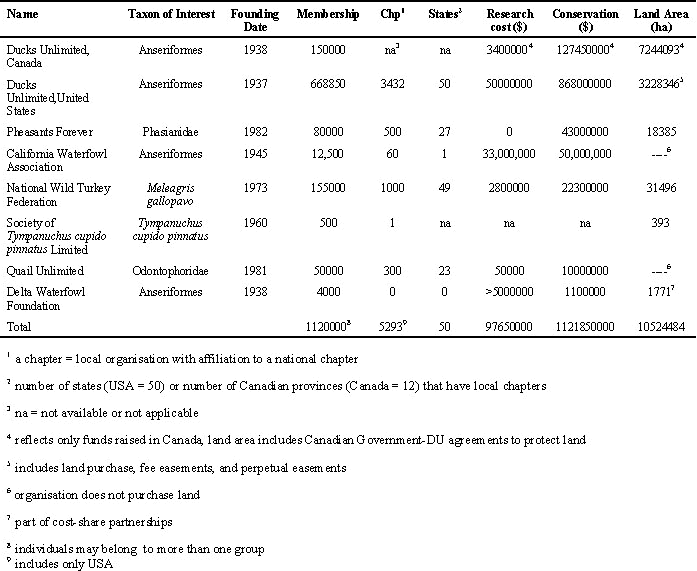
Table 4. Current status of birds in southern pine forests and savannahs of the United States that have affinities for habitats maintained by frequent fire, from Brennan et al. (1998).
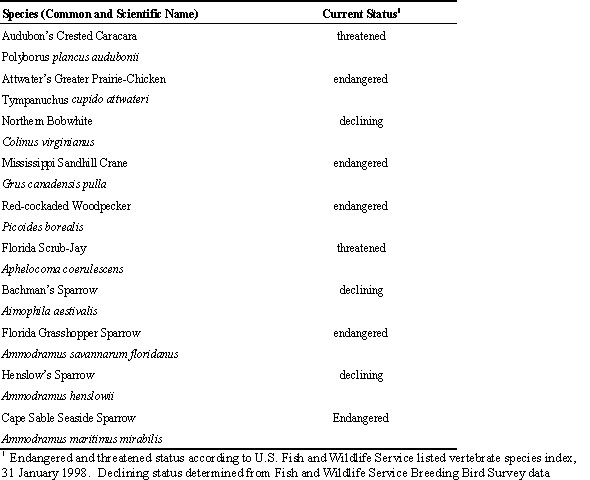
Table 5. Response of selected birds to cessation of annual prescribed fire on an 8.6 hectare experimental plot at Tall Timbers Research Station, Tallahassee, Florida, USA, from Engstrom et al. (1984).
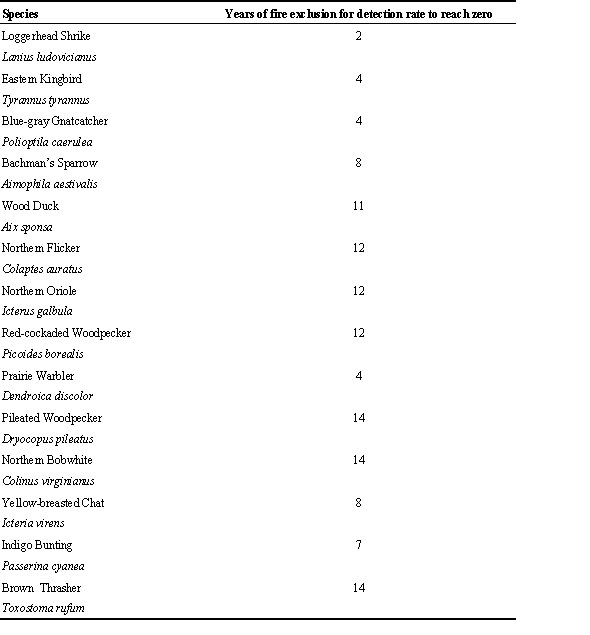
Table 6. Detection rates of selected bird species in response to use of frequent (every 3 years) prescribed fire for Northern Bobwhite and Red-cockaded Woodpecker habitat management at the Beinville National Forest and Noxubee National Wildlife Refuge, Mississippi, USA, May-June 1995, from Brennan et al. (1995).
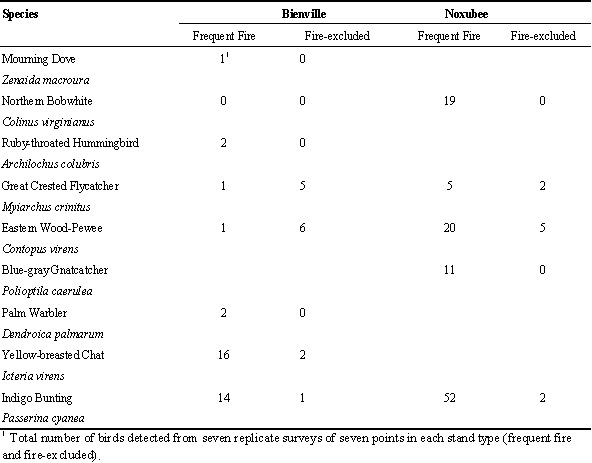
Table 7. Average frequency of detections of birds in pine-oak woodlands on burned and unburned plots in the Ouachita National Forest, Arkansas, USA, May 1992 and 1993, from Wilson et al. (1995).
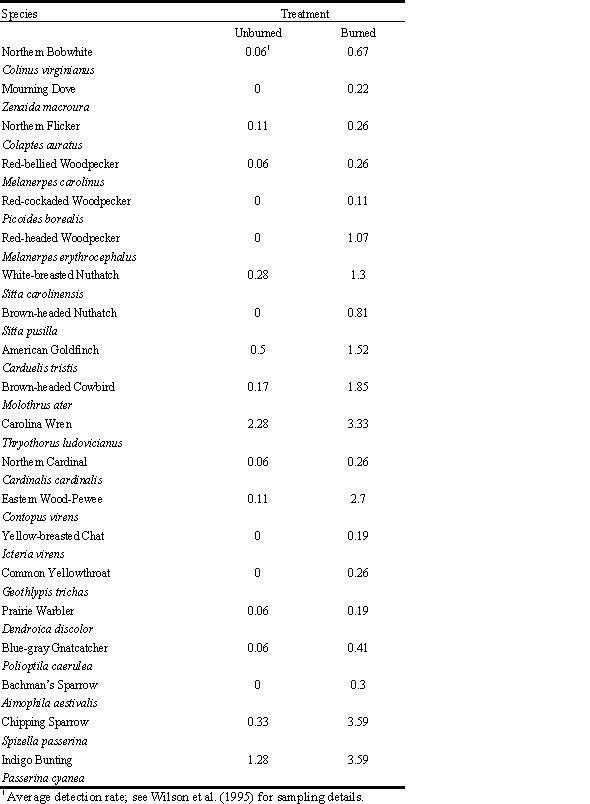
Fig. 1. Economic impact of hunting in the United States. A. Total amount of expenditures among broad categories of game animals. B. Relative proportion of expenditures among broad categories of game animals. (Source: U.S.D.I. 1996).
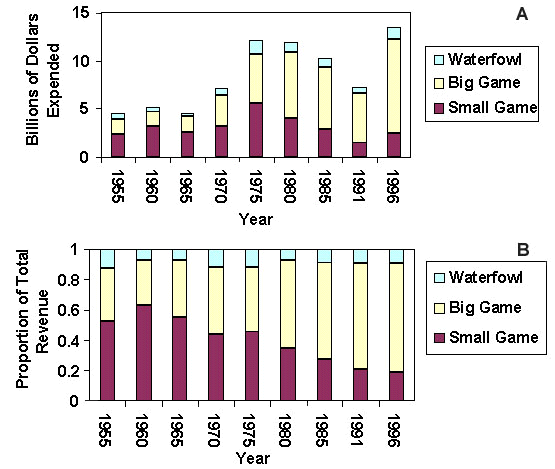
Fig. 2. Trends in number of hunters (by broad category of game animals pursued) and number of wildlife watchers in the United States. (Source: U.S.D.I. 1996).
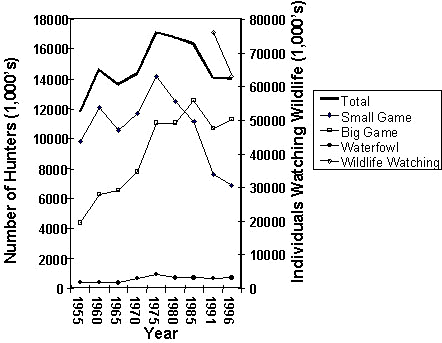
Fig. 3. Habitat conservation resulting from dedicated funds. (A) Total amount of money generated from Federal excise taxes and duck stamps from 1962-1996. (B) Amount of habitat conserved using these funds. (Source: Personal Communication, United States Fish and Wildlife Service).
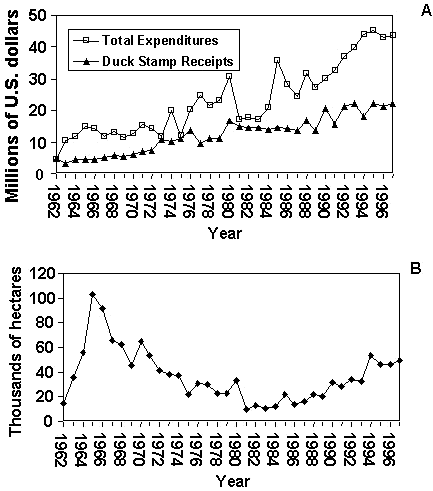
Appendix 1. List of non governmental organisations contacted (respondents noted in italics).
